This being bear country, no food is permitted in the structure, but outside was a picnic table and a propane barbecue locked inside a bear-proof storage locker, and, of course, a firepit. Knowing we didn’t need to hump our own dwelling, we packed lightly and opted for the quintessential camping meal: Potato chips and hotdogs (or even better; potato chips on hotdogs). With s’mores as the sun went down, it felt like we were really camping.
Tent-cabin hybrids coming to Fort Rodd Hill campsite
Here is the same company that made the Prospector's tent - in the above video -
featured in that article.
Somewhere between a tent and a cabin is an oTENTik — and you’ll be able to camp in one soon at Fort Rodd Hill National Historic Site.
The made-in-Canada camping structure has been sprouting up since last year throughout the Parks Canada system.
The oTENTik — the name was created by manufacturer Biome-Canada — features a tent-like exterior along with a wooden floor and walls.
Otentiks are basically wood-framed prospectors cabins with canvas walls. The name is a play off the word “authentic,” with the federal government stamp of approval for sounding silly in both official languages.
So considering my Hermit Hut does not even have a floor - and the walls are pliable - as is the requirement for a tent structure - then it really is a Tabin.
This vid is the infamous Minnesota Tent-cabin hybrid - a winter visit
So one of the other similar features is that these tents have REAL DOORS!! So just as I created a door for the Hermit Hut - that does not exclude it being a tent.
So with that Minnesota tent - he also has plywood walls!! So that really cinches the case that I also have a "tent."
So that is definitely more of a cabin than a tent - yet he calls it a TENT.
This is how the oTENTik is built video
oTENTik, exclusive to Parks Canada, is a cross between an A-frame cabin and a prospector tent mounted on a raised wooden floor.
Yeah so it has roof beams - just as I have.
What's a "roof toit"?
So it's some kind of solid canvas roof paneling?
Ok there are several vids of the Canada Park system using the Tent Cabins of oTENTik. Now let's move on to another company -
https://totallyuniquecabins.com/ featuring the Tent Cabins
Here you go - the 10 x 12 Canvas Shack!Tent Cabins were well known during the 1860s forward wave of the American westward expansion. They are still popular today, lived in at camp, and are as American as apple pie.
So it even has a solid wood wall base around it - so yes this is very similar to the Hermit Hut.
left up for year round for seasonal use.
They want $4500 - the big difference with the Hermit Hut is I have amazingly good insulation!! But that confirms that it is legally a tent for seasonal use.
The North American Tent Cabin Company
Helping Make The "Authentic" American Camp
These Tent Cabins look nice but lack the insulation.
a 45-degree canopy slope and five-foot sidewalls.
OK so that's what the other company also uses.Canvas ceiling and wall panels
Now the Canvas Cabin a classic style for the fixed campYep that is precisely what I have. So the owner is emphasizing these are NOT a "living dwelling" - meaning again that by building code they are a TENT and not a yurt or tiny house. Very awesome. This is precisely what I was looking for.
Oh that company is nearby also - Wisconsin!!
cool.
ArchiTENTure = a cabin and a tent in onevideo of "House of 3 tents" - another company
So that uses nylon - with wood framing.
Ah - fascinating!....So that is part of the tent code definition?Do I need a license to install a Biome-Canada product?
Our products are defined as tents (oTENTik, Yurt, Minka, Pendola, Quadra, etc.). In a tent, normally there is no running water or sanitary equipment. The installation of a tent does not require a license on private land. For permanent installations, please contact us, we will provide you with all relevant information for your project. You will subsequently be able contact the competent authorities.
sanitary industrial processing equipment such as valves, pumps, and more from manufacturers
Sure enough - this vid shows wood post foundations for the Tents!
This composting toilet is completely self-contained, and can safely be used in places where there is no plumbing or sewage facilities.So by "sanitary equipment" I think they mean "plumbing or sewage facilities."
sewage shall be directly connected to the sanitary drainage system of the building
 |
| Eco-Tents on the top hillside |
Yep. No sewage means no sanitary equipment!
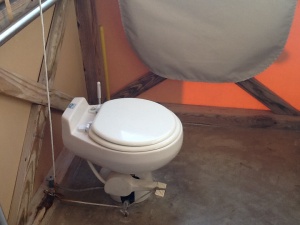 |
| Composting toilet inside eco-tent. Concordia Eco Resort, St. John, U.S. Virgin Islands. |
Concordia Eco Resort, St. John, U.S. Virgin Islands.
The house sewer connects a single building's sanitary plumbing facilities.
- In today's flush based urban sanitation systems, toilets are connectedhttps://unenuitdanslapampa.com/en/the-fixed-campsite/
This company is in Spain.
57% of English campers prefer a FIXED CAMPSITE for the entire duration of their holidayhttps://www.temehu.com/hotels/camping.htm
Fixed Campsite huts in Libya
The buildup of human waste near a fixed campsite can attract bears and other wildlife. Faint odors that humans cannot detect can be picked up ...This is why I use lime wood ash and then compost.
http://www.campminsi.org/weekend-camping-facilities/61022Camp Minsi's tabins (tent/cabins) provide a unique camping experience. ... Each tabin is equipped with wood stoves that make them warm cozy even in the ...
Wow - so cool! This is exactly like what I made!
Only again I don't have a floor.
Camp Minsi's tabins (tent/cabins) provide a unique camping experience. These hard-wall shelters, with dual-layer canvas roofs sleep 8 Scouts with built-in bunks. Each tabin is equipped with wood stoves that make them warm cozy even in the coldest weather. The Winter Meal Lodge (the summer camp nature lodge) is available as a cooking and dining space for units using the tabins.So I have a pliable-wall shelter as I previously blogged. I have a tri-layer canvas roof!
Serendipity
The newest unit, Serendipity ,is a group of 7 “tabins” – colorful “tent-cabins”. Each tabin sleeps 4, for a total of 28 at the campsite. Serendipity was built in 2006.
Wow - very similar.
More Tabins at scout camps
and another site!
Cabins or “Tabins” are small screened-in cabins, with cots or bunk beds inside. Sleeping in one is similar to sleeping in a screened-in back porch.Yeah I think that's the same camp site.
And now more Tent Cabins
quite the locale!
and in Venezuela
Yosemite Park Tent Cabins
and Big Basin?
35 tent cabins are nestled in the redwoods.But wait there's more!
The tent cabins are made of wood and canvas, and most measure 12 by 14 feet, with two full-size beds, a table and a wood stove. Wood bundles are available to buy for fires to make it toasty inside.
cool.
Tent cabins are made up of wooden floors, canvas walls & a canvas roof – a combination between a tent & a rustic cabin. Most have sleeping cots for beds; some have heaters, wood burning stoves or electrical outlets. A shared community bathroom is close by.And a Civil War miniature Tent Cabin!
A civil war officer's wall tent with stove, floorboards, and a log base. The type of quasi permanent structure found all over the American West at mines and lumber camps where permanncy was not expected.
Photo: “Tent cabin”
From Review:
Durmiendo entre sequoyas
of Grant Grove Cabins
Now on to Civil War Tabins!
Others were haphazard arrangements of tents, cabins, and cabins with tent roofs. Each building style was different as well. Some structures were no more than a hole dug into the earth with a tent over top, while others were multi-man cabins complete with fireplace, chimney, and bunks. The typical cabin was a simple affair. Soldiers cut logs from the surrounding country side, built their cabins next to brick and mortar chimneys, and roofed the buildings with tent canvas. Interestingly, the style of cabin sometimes pointed to the ancestry of the builders. For example, Soldiers of Scandinavian descent generally built their cabins with the logs vertical, while those of German descent built with the logs horizontal with notches at the corner to minimize the use of nails.
fascinating.
Wow a whole field of Tabins!!
Prospector Tent video



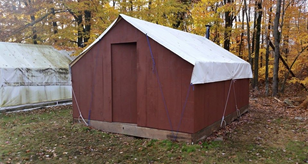




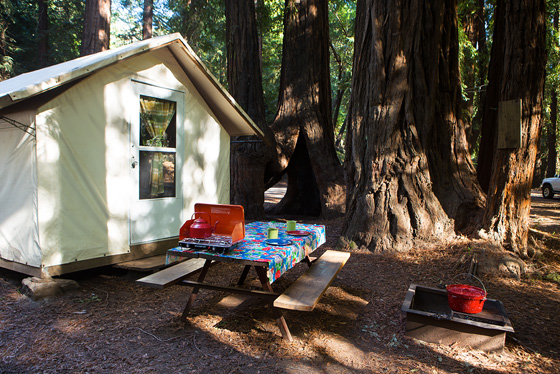
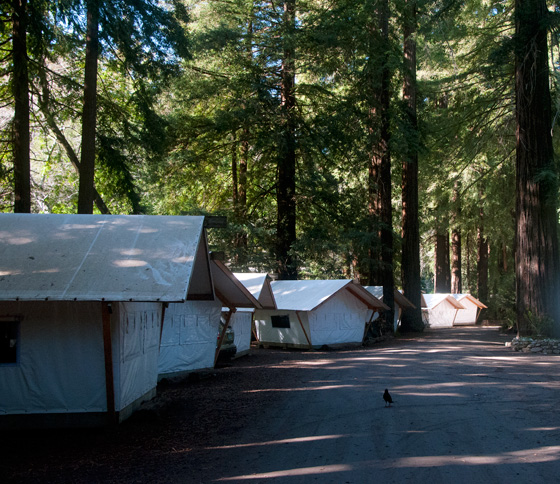
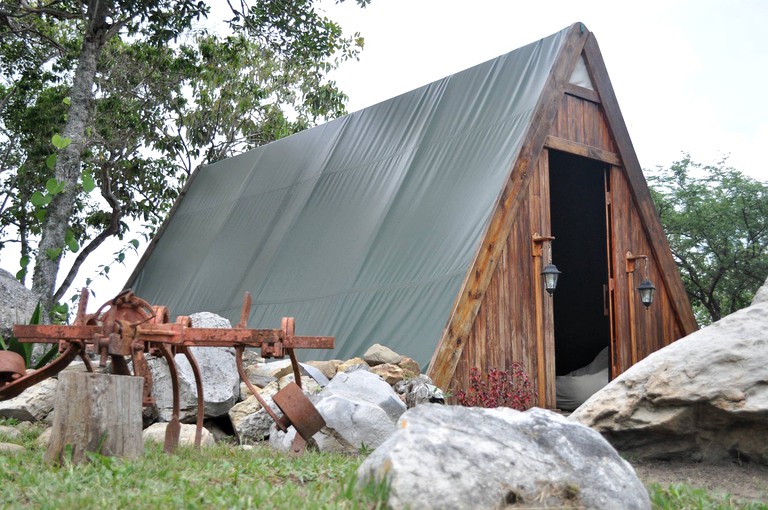


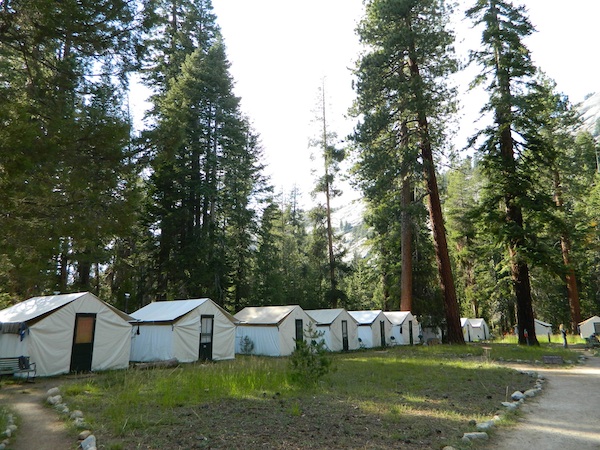
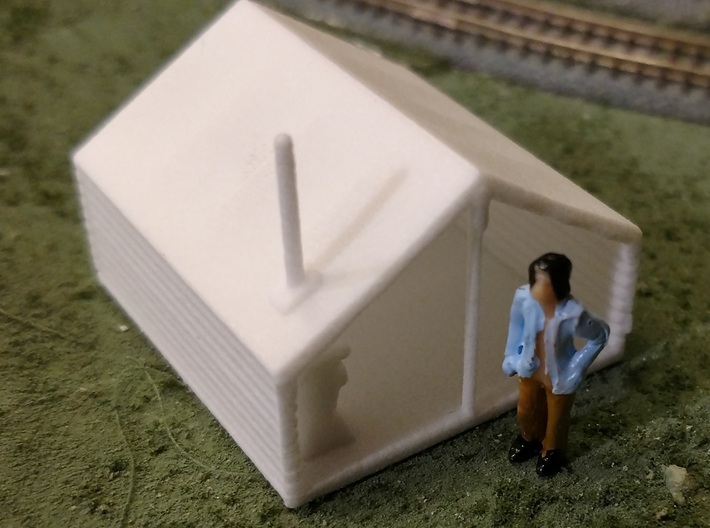

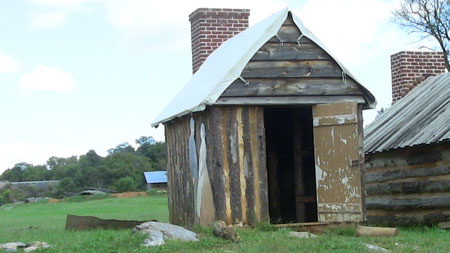

No comments:
Post a Comment